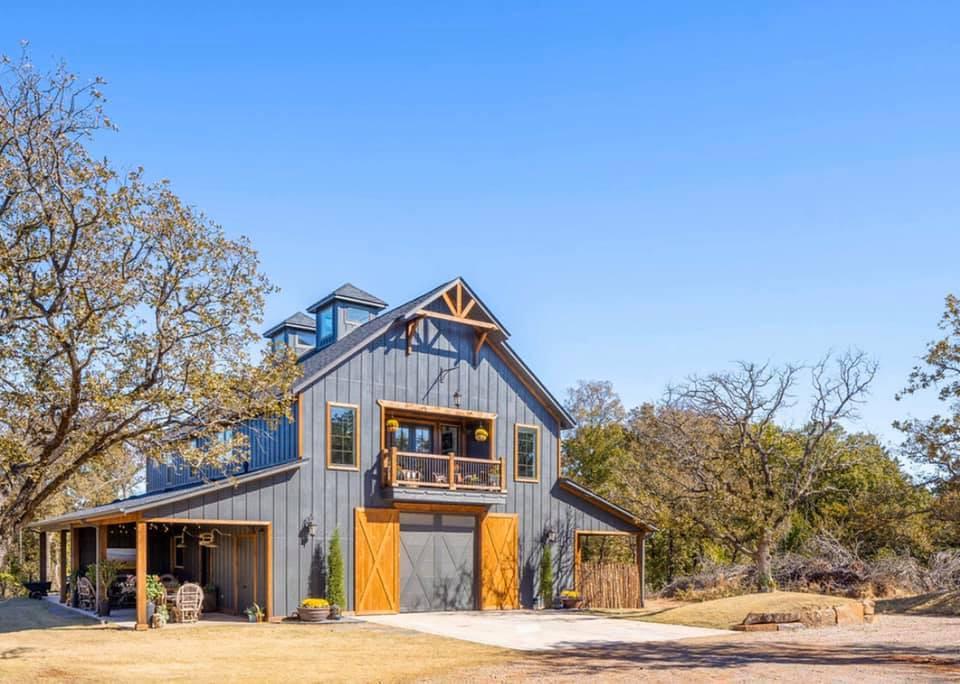If you revel in the rustic and go ballistic over barn-style anything, then barndominium living may be for you.
So what is a barndominium? It’s an oversized building that’s either a retrofitted barn-to-home conversion or an open-concept steel building constructed from the ground up. It is usually built on a plot of land in rural areas where land is abundant, but this type of structure has also started popping up in exurban locations.
“Barndominiums as a design concept are booming,” saysOliver J. Bell, CEO of Our Barndominium Life.
Compared with traditional wood-framed houses, barndominiums are faster and more affordable to build, are more durable, and require less maintenance.
But before you jump on the bandwagon and begin construction—whether it’s on an existing barn or a brand-new kit—you want to do your research. Here are the most important things to know about building a barndominium.
1. Obtain a permit for your project
Photo by Bridger Steel, Inc.Anyone taking on a building project or remodel is required to obtain the proper permits to make sure everything is up to code. When building a barndominium, it’s important to budget for permits, which can cost anywhere from $400 to $2,000 depending on where you reside.
Your local department of building and safety will often have size and style requirements for your build, as well as requirements for septic tank installation, electrical wiring, and plumbing.
And if you’re buying a property that has a preexisting barn, never assume that it was built to code or with the necessary permits. Get in touch with the local planning office to find out what you can and cannot do to retrofit your barn.
2. Test the paint
Photo by Justin Doyle HomesWhen refurbishing an older barn, it’s important to determine what type of coatings were originally used.

Matt Kunz, president of Five Star Painting, says older barns that predate 1978 may have lead paint on the exterior and interior spaces, windows, walls, trim, and siding.
These areas may be disturbed during refurbishment and need to be tested prior to the work beginning. If the test is positive, Kunz says the cost to fix the issue can be considerable and depends on the barn’s size.
3. Prepare for surprise costs
Claim your home to stay up-to-date of your home‘s value and equity.
Photo by John Lively & AssociatesBuilding or retrofitting a barn to live in costs considerably less than a traditional house, but that doesn’t mean unexpected costs won’t pop up during the construction.
Don’t underestimate the cost to clear the terrain and prepare the site for construction. You also might need to lay a new foundation, which can cost from $5,000 to $30,000 depending on your location and the type of foundation.
You’re turning a typically uninhabited structure into a livable space, so you’ll need to budget for modern conveniences that’ll make it feel like home. This can include HVAC, tile or hardwood flooring, and washer and dryer hookups.
4. Plan for electrical work
Photo by J Baxter ConstructionFor a basic barn, electricity is not something that needs to be considered. But a barndominium can’t go without electricity, so it’s important to consider the electrical requirements—and to consider them early.
Hire a licensed and skilled electrical company and have it review the power specifications for all the appliances and lighting that will be installed throughout the home. The company should also make sure all the wires are in the precise location you need them to be.
“Once the Sheetrock or walls are in place, it takes much more labor to rework things,” says Sean Dion, owner of Mr. Electric of Queensbury, NY.
Choosing your lighting (both the type of lighting and the fixtures) can be overwhelming, but make your selections early to assure they’ll be available when it’s time for installation. You may also want to include smart thermostats, doorbells, security lighting or devices, and smart switches in your renovation.
Any changes to a project after the contract is signed can be costly.
5. Choose your windows and doors wisely
Photo by ActivWallHigh energy costs are often attributed to drafty windows and doors. So, to make sure your energy bill won’t spike in your barndominium, choose double- or triple-pane windows and a fiberglass or insulated steel front door.
To bring more natural light into the home and embrace indoor-outdoor living,Brad Roberson, president of Glass Doctor, suggests incorporating a sliding glass door into your design.
When shopping for a sliding glass door, “look for composite gaskets, double-pane glass, and other features designed for energy efficiency,” says Roberson.
6. Add insulation—it’s important
Photo by Ameribuilt Steel StructuresSince barndominiums are constructed with steel frames and metal walls, they are not good at holding a steady temperature and can accumulate heat during warm weather and lose heat in the winter.
To remedy this issue, experts recommend using batting for insulation, or using foam boards, insulated panels, and spray foam insulation to give more heat resistance.








